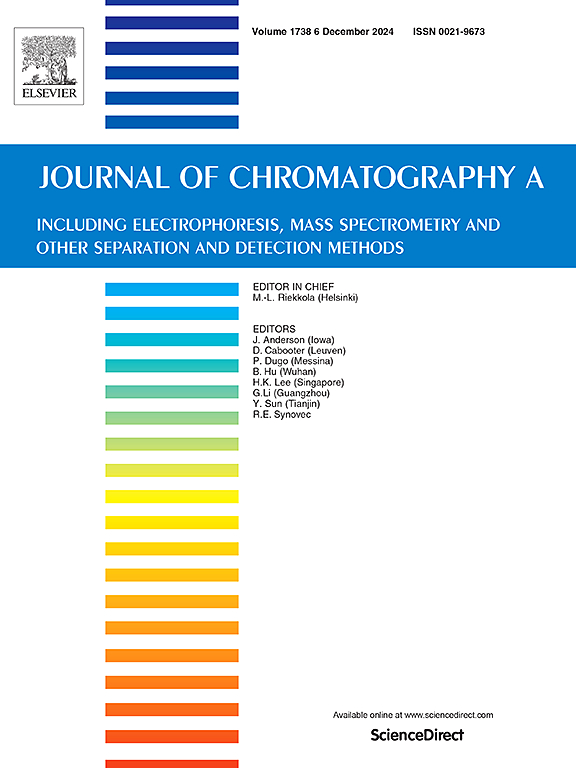液相色谱的多尺度模拟:大型多孔床中的有效扩散和板高方程的 B 项。
IF 3.8
2区 化学
Q1 BIOCHEMICAL RESEARCH METHODS
引用次数: 0
摘要
我们对用于反相液相色谱的硅胶整体柱的分层孔隙度模型中的分析物吸附和扩散进行了多尺度模拟,以研究色谱床的平均中孔尺寸以及分析物与色谱界面的相互作用如何在不同长度尺度上影响分析物的扩散性。再现的实验条件包括在以二氧化硅为基质的端帽 C18 固定相上保留六种低至中等溶质极性的分析化合物,流动相为水-乙腈和水-甲醇,其洗脱强度通过体积溶剂比来改变。从分子动力学模拟中获得的有关特定分析物界面动力学的详细信息,通过适当的链接器方案被纳入布朗动力学扩散模拟中,这些模型来自平均大孔尺寸为 1.23 µm、平均中孔尺寸为 12.3、21.3 或 25.7 nm 的二氧化硅单片的物理重构。研究发现,平均中孔尺寸对有效中孔扩散率的影响与分析物极性和流动相洗脱强度相似,它们共同决定了分析物在色谱柱上的停留时间。中孔尺寸越小,有效中孔扩散率随流动相洗脱强度增加而增加的幅度就越大。有效床层扩散率受分析物停留时间的限制,而不是介孔空间形态细节的限制。中孔内的色谱界面对分析物的截留作用越强,孔隙空间层次之间的传质就越慢,有效床层扩散率就越低。通过分析分析物-结合相接触获得的静止相极限的附加信息,利用分层孔隙度模型得出的床层扩散率和基于相的保留因子,最终生成了板高方程的 B 项。B 项凸显了色谱实践中与等度和梯度洗脱条件相关的分析物和流动相的特定行为。特别是,在流动相的低洗脱强度和高洗脱强度下,由于保留因子和床层扩散率对 B 项的贡献占主导地位,因此观察到 U 型 B 项曲线。本文章由计算机程序翻译,如有差异,请以英文原文为准。
Multiscale simulation of liquid chromatography: Effective diffusion in macro–mesoporous beds and the B-term of the plate height equation
We performed multiscale simulations of analyte sorption and diffusion in hierarchical porosity models of monolithic silica columns for reversed-phase liquid chromatography to investigate how the mean mesopore size of the chromatographic bed and the analyte-specific interaction with the chromatographic interface influence the analyte diffusivity at various length scales. The reproduced experimental conditions comprised the retention of six analyte compounds of low to moderate solute polarity on a silica-based, endcapped, C18 stationary phase with water‒acetonitrile and water–methanol mobile phases whose elution strength was varied via the volumetric solvent ratio. Detailed information about the analyte-specific interfacial dynamics received from molecular dynamics simulations was incorporated through appropriate linker schemes into Brownian dynamics diffusion simulations in three hierarchical porosity models received from physical reconstructions of silica monoliths with a mean macropore size of 1.23 µm and mean mesopore sizes of 12.3, 21.3, or 25.7 nm. The mean mesopore size was found to have a similar influence on the effective mesopore diffusivity as the analyte polarity and the mobile-phase elution strength, which together determine the analyte residence time on a column. A smaller mesopore size attenuated the increase of the effective mesopore diffusivity with increasing mobile-phase elution strength significantly. The effective bed diffusivity was limited by the analyte residence time rather than by morphological details of the mesopore space. The stronger an analyte was retained by the chromatographic interface inside the mesopores, the slower became the mass transfer between the pore space hierarchies and the lower was the effective bed diffusivity. The B-terms of the plate height equation were finally generated with the bed diffusivities and phase-based retention factors derived from the hierarchical porosity models using additional information about the stationary-phase limit obtained from the analysis of analyte–bonded phase contacts. The B-terms highlight analyte- and mobile phase-specific behavior relevant to isocratic and gradient elution conditions in chromatographic practice. In particular, U-shaped B-term curves are observed due to the dominating contribution of the retention factor and the bed diffusivity to the B-term at low and high elution strength of the mobile phase, respectively.
求助全文
通过发布文献求助,成功后即可免费获取论文全文。
去求助
来源期刊

Journal of Chromatography A
化学-分析化学
CiteScore
7.90
自引率
14.60%
发文量
742
审稿时长
45 days
期刊介绍:
The Journal of Chromatography A provides a forum for the publication of original research and critical reviews on all aspects of fundamental and applied separation science. The scope of the journal includes chromatography and related techniques, electromigration techniques (e.g. electrophoresis, electrochromatography), hyphenated and other multi-dimensional techniques, sample preparation, and detection methods such as mass spectrometry. Contributions consist mainly of research papers dealing with the theory of separation methods, instrumental developments and analytical and preparative applications of general interest.
 求助内容:
求助内容: 应助结果提醒方式:
应助结果提醒方式:


